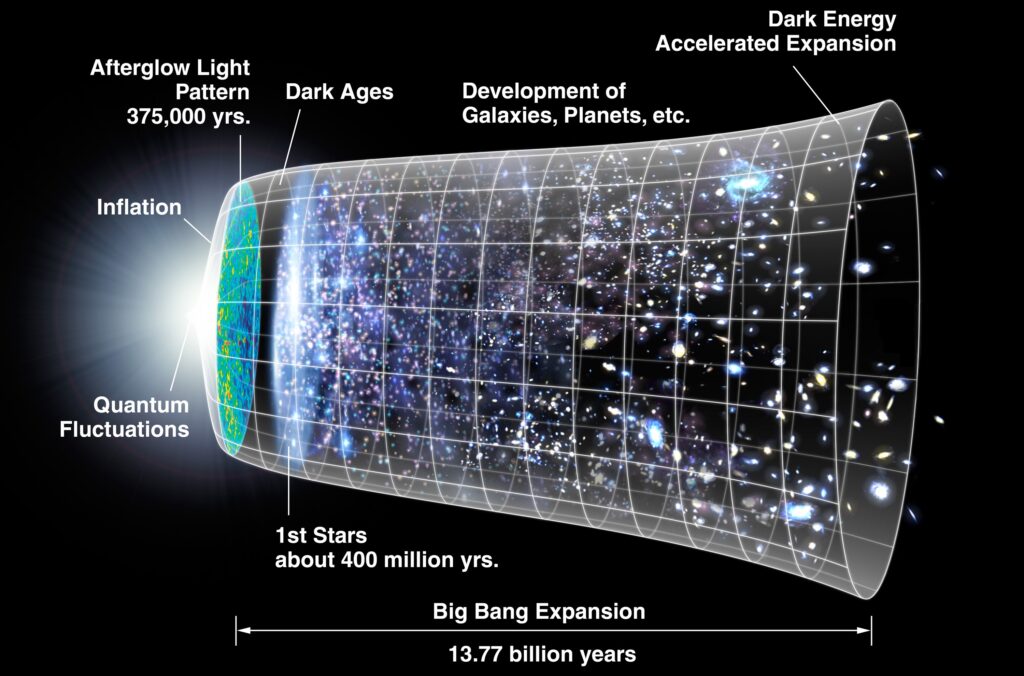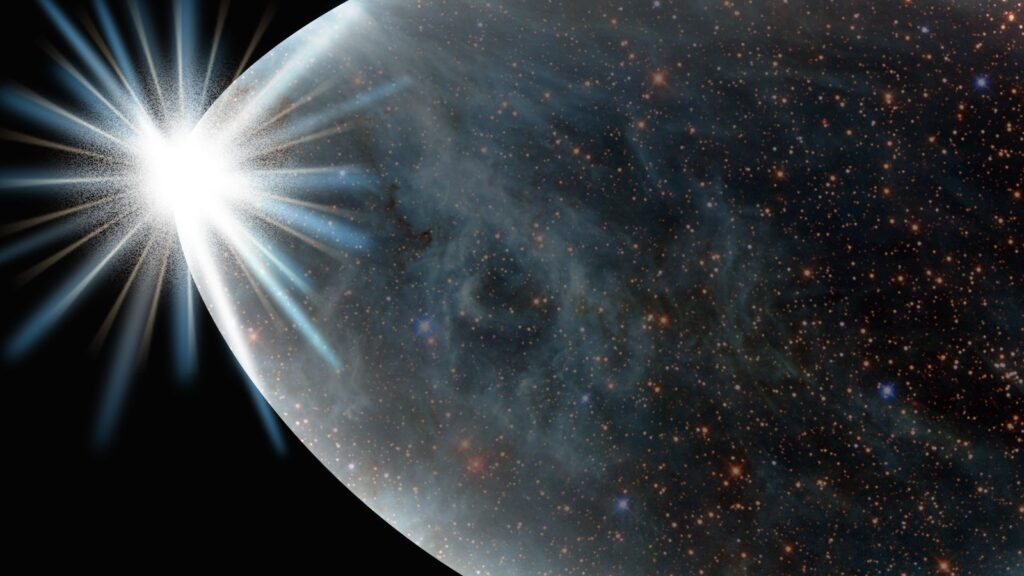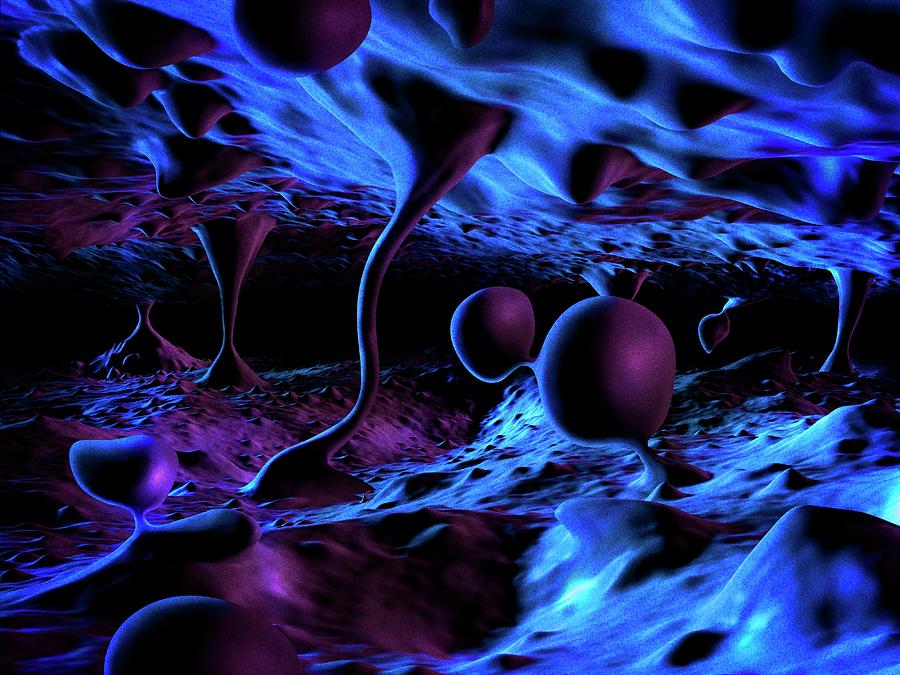The Big Bang theory describes the birth of the Universe and everything that happened to it during its further evolution. But it does not answer many important questions. And one of them is what actually caused the Big Bang? Where did the energy for it come from and where is the source of the primary quark-gluon plasma from which all known elementary particles were formed?
The limit of known physics
As we already know, we can only build theories about the first fractions of a second of our Universe’s life — all the artifacts available today testify only to its later stages of evolution. They certainly bear the imprint of the first, but they are only indirect evidence of the strange states in which matter was in the first moments of its life.

However, when we go back into the very deep past, we face a more serious fundamental problem. Scientists have a limited ability to study the quark-gluon plasma on Earth in their laboratories using particle accelerators. Although the energies at which particles collide in modern accelerators (colliders) are extremely high, they are still limited by current technology — the power of the accelerating fields, the strength of the guiding magnets, the size of the collider, etc. In the most famous and powerful device of our time, the Large Hadron Collider, protons collide today with energies of 13 teraelectron volts. The “thermal” collision of particles with such energy was characteristic of the Universe in its first hundred billionth of a second of life. But no one has yet investigated the behavior of matter at even higher energies and, accordingly, at earlier stages: assumptions about them become more and more illusory as we approach the beginning of the world.
Scientists hope that there is a single fundamental theory that can describe all known interactions in the Universe (gravitational, electromagnetic, weak, and strong) at once. Today, for example, we do not know exactly what the theory of quantum gravity should look like. Testing such a theory is possible primarily at ultra-high energies and densities of matter, which are not available not only on Earth but almost anywhere else in the modern Universe. The very early Universe would have been an excellent laboratory for the study of such grand unification theories, as they are commonly called.
According to cosmologists, at 10-36 — one sextillionth of one sextillionth — seconds after the birth of the Universe, the energy of particles (about 1015 GeV) in it was sufficient to unite all forces except gravity. This is about a few thousand times more than the energy of the highest-energy particle ever recorded (such particles come to us in the form of cosmic rays). If we try to translate this energy into the usual “temperature”, we will get 1028 degrees Kelvin — one and 28 zeros. Needless to say, it is impossible to comprehend such a temperature with our limited imagination. For the gravitational force to play a significant role in particle interactions, the energies must be several orders of magnitude higher. Probably in the very early Universe еhe so-called “Planckian” values of density, temperature, and distance and time between interactions existed — values that break the very structure of space-time. For example, scientists believe that time intervals shorter than the Planck time (10-43 s) cannot exist. At this point in time, the entire visible Universe would have to fit into a ball with a radius of 10-37 m, the Planck distance.
But let’s stop throwing zeros around. Let’s ask the most important question: where did matter itself, as we know it, come from? Today, cosmologists believe that the most likely scenario is the birth of all known particles from the primary field. It is also called the inflationary scenario because it led to cosmic inflation, the hypothetical first stage of the evolution of our Universe.
Problems of initial conditions and cosmic inflation
Almost immediately after the “victory” of the Big Bang theory over other alternative theories of the evolution of the Universe, this theory faced several problems that could not be explained. The most serious of them, perhaps, is the problem of initial conditions. First, when studying the relic microwave background, cosmologists noticed that the early Universe was too homogeneous. It would seem that this is not surprising for a gas or primary plasma — after all, the gas in your room or, for example, on the surface of the Sun is homogeneous. But the nuance here is in the scale. At the time of the birth of the relic background, the Universe occupied a volume about a thousand times smaller than today, its radius was only 4 billion light-years (versus today’s 45). And yet, it is an impressive volume! And throughout this volume, the plasma temperature was approximately the same. However, at that time, our world existed for too short a time for the gas in different regions to come into equilibrium within itself: as you remember, the speed of light is finite, and only points at distances several tens of thousands of times smaller than the radius of the Universe at that time could be “causally related.” How, then, did it become almost perfectly uniform in such a large volume?

An inflationary scenario — developed in the 1970s and 1980s by Alan Guth, Andrei Linde, and Alexei Starobinsky — suggests the following explanation. All these unconnected regions had contact earlier, when the Universe was even smaller. And they were “blown apart” to causally unrelated distances (cosmologists say “beyond the Hubble horizon”) during cosmic inflation, the exponential expansion of the Universe immediately after its birth. It was caused by the presence of the primary inflationary field. The expansion changed the ratio of kinetic and potential energy of the field, which led to its decay into ordinary matter and the end of inflation. But in an incredibly short time (10-43 — 10-36 s), the Universe increased its volume billions of billions of times.
Cosmic inflation also solves some other problems of the Big Bang theory, such as the inability to observe some exotic objects (topological defects). All such objects were taken out of the observable Universe by inflation. However, this theory also has quite a few authoritative critics, including the now Nobel laureate Sir Roger Penrose.
Still, there is one more question that space inflation does not solve, but, as some physicists joke, shyly hides under the carpet. In simple terms, it can be formulated as follows: “At whose expense is this luxurious feast?” By “banquet” here we mean our Universe and all the swirling energy and matter that is present in it. But we are also aware of the inexorable principles of thermodynamics. The first raises the question: where could this energy have come from? The second one is also troubling: what brought the Universe to its initial extremely low-entropy (unlikely) state? Who or what “wound it up” like a clockwork alarm clock so that it could ring for so long? Perhaps the quantum birth of our world provides answers to these questions.
A birth from a fluctuation?
How often do you think you encounter quantum spontaneous processes in your everyday life? You might be surprised, but believe me – you do! Most of the photons that we see as light were born in the spontaneous transitions of electrons from excited energy levels to stable ones in atoms and molecules. Quantum tunneling can also be considered spontaneous. This means that all radioactive decays are spontaneous quantum processes for which it is never possible to specify exactly when they will occur, only to calculate the probability that they will occur at a certain time interval.

Quantum fluctuations occupy a special place in quantum field theory (QFT). These are also spontaneous quantum transitions. According to the postulates of this science, all space is filled with zero-point fluctuations of all existing fields. Thus, from the point of view of QFT, a vacuum is not an empty space at all. These fields are characterized by fluctuations – short-term deviations from the average value (zero energy level in this case). Accordingly, the vacuum is constantly seething with these small deviations. Scientists call them virtual particles because of their short lifespan and some other properties that distinguish them from real particles. Nature, however, is arranged in such a way that the birth of virtual particles “out of nothing” does not violate its fundamental laws – in particular, the laws of energy conservation. And yet these fluctuations have a very real impact on the world of real particles. They cause such effects as the “Lamb shift” (a subtle change in the spectrum of energy levels in a hydrogen atom due to the interaction of an electron with virtual photons), as well as the Casimir effect and others. And the above-mentioned spontaneous transitions in atoms are also a consequence of interaction with zero-point fluctuations of the electromagnetic field in vacuum.
The idea of the quantum birth of the Universe is that the primary field emerged from this “non-empty” vacuum as a fluctuation from its zero level. Yes, the inflaton field is quantum, like all the fields in our world, and it also has fluctuations. At some point in time (if this category could exist before the birth of the Universe), it moved from the zero level to the excited level in a certain region of space (if this category could also exist before the birth of the Universe). However, in this case, theorists still need to do a lot of work to explain how the virtual fluctuation became real and acquired such a large initial value to “drive” cosmic inflation and give birth to all other fields after that.
Will it ever be possible to find a strict confirmation of this hypothesis? Who knows… Some hints of its truthfulness can be found in the characteristics of matter perturbations that we observe in the Universe today. They somewhat resemble the perturbations generated by quantum fluctuations. There is also a faint hope of picking up, directly or indirectly, the primordial gravitational waves – a background similar to the relic microwave and neutrino waves you already know about. These waves were born right after the end of cosmic inflation and can bring a lot of interesting information about our world in these first tiny fractions of a second of its existence. As for the law of conservation of energy, modern cosmologists believe that all the positive energy of the Universe is offset by the negative potential energy of the gravitational attraction of matter, but this will probably never be verified either.
I would like to end this story with a small and pleasant surprise. The fact is that the idea of the quantum birth of the Universe was born… in Ukraine! We are talking about the work of the famous theoretical physicist Petro Fomin, who in 1973, working at the Bogolyubov Institute of Theoretical Physics in Kyiv, first showed that the combination of the principles of General Relativity and QFT leads to the phenomenon of gravitational instability of the vacuum, which makes it possible to spontaneously create a spatially closed Universe. Another scientist from Ukraine who has contributed significantly to this theory is Oleksandr Vilenkin, a world-renowned cosmologist, a native of Kharkiv and a graduate of Kharkiv University, who now works in the United States.
The quantum birth of the Universe is an elegant idea, as bright as the flash of a supernova, which nevertheless requires further study, research and reflection.
Author: Maksym Tsizh, PhD in Physics and Mathematics, Researcher at the Astronomical Observatory of Lviv University
This article was published in Universe Space Tech magazine #6(187) 2021. You can buy this issue in electronic or paper versions in our store.

